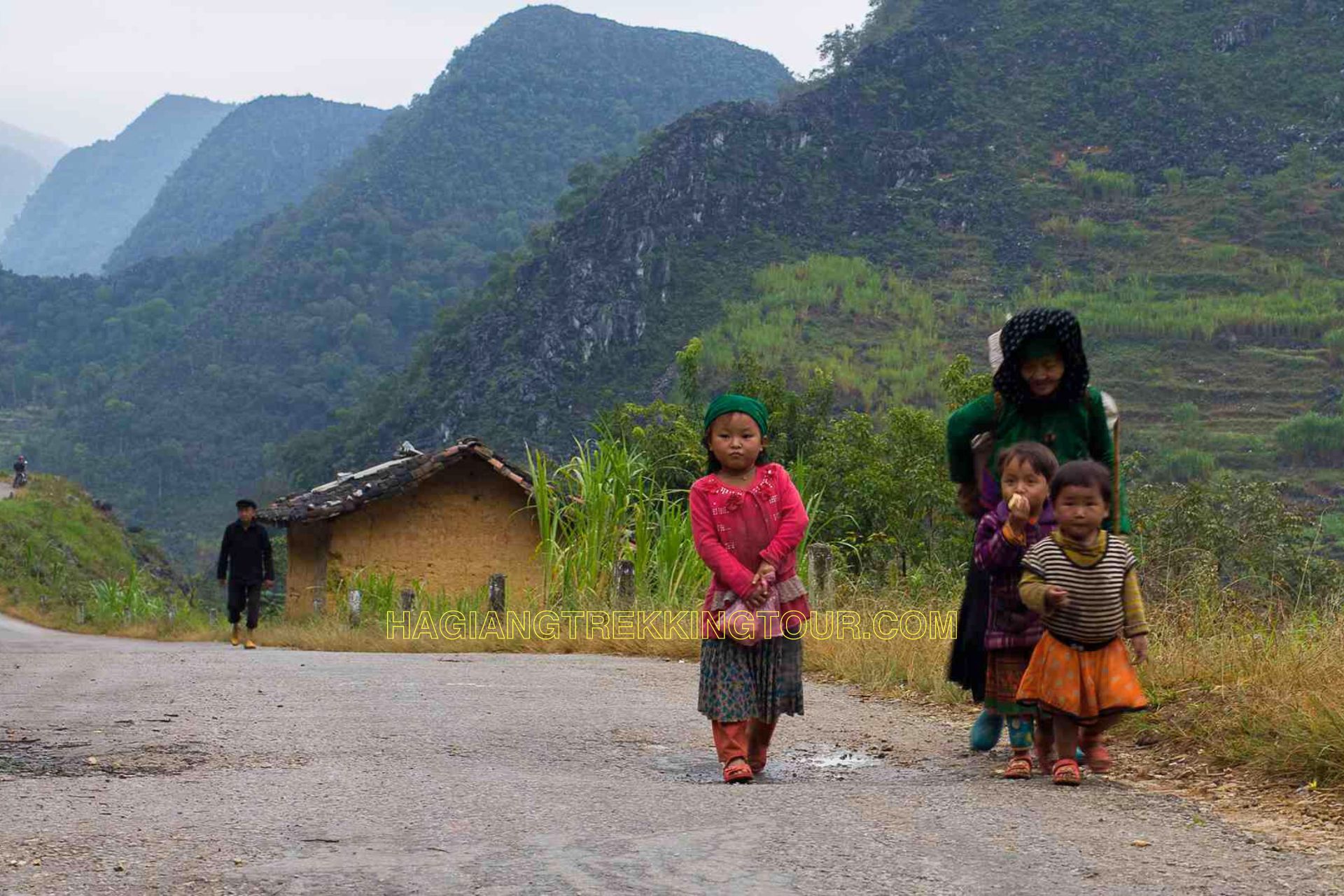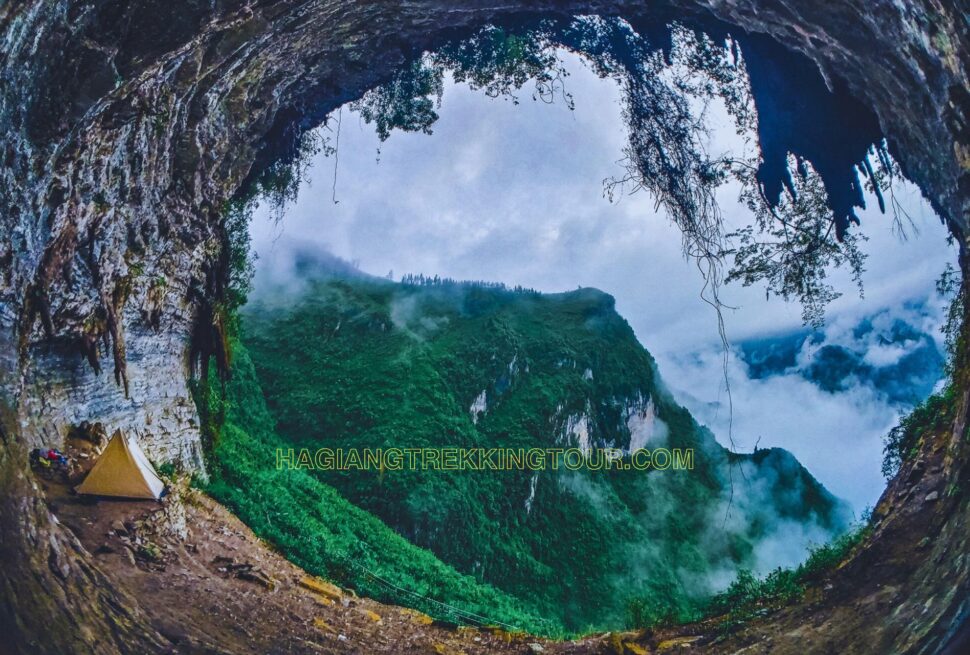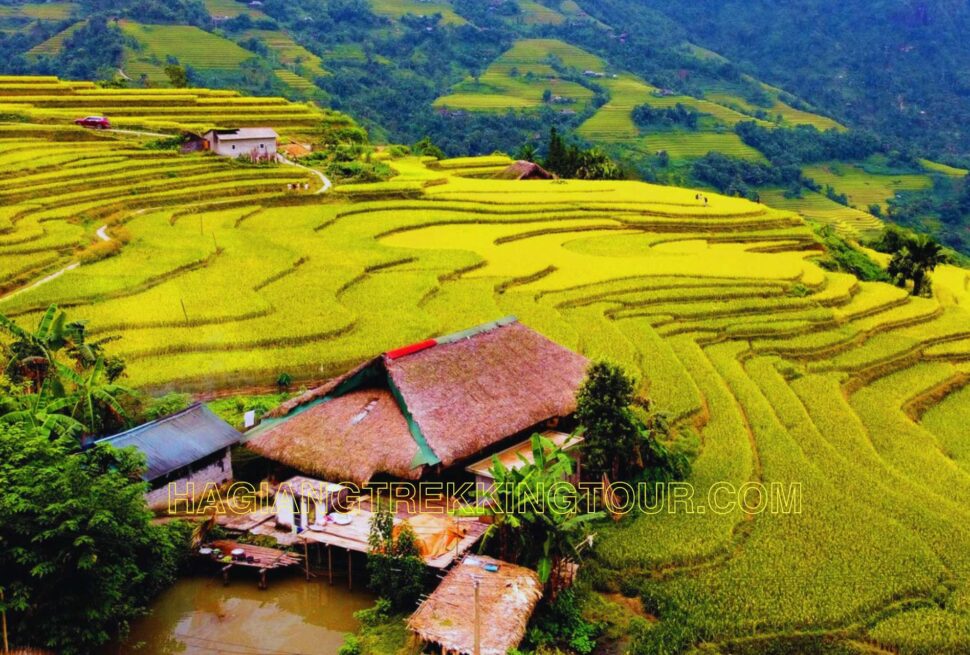1. When is the best time to travel to Ha Giang?
Ha Giang, with its wild and majestic beauty, is an ideal destination for nature lovers and those looking to explore the unique culture of ethnic minorities. However, the timing of your visit is crucial to fully enjoy the beauty of Ha Giang.
- October – December: This is when Ha Giang is covered in the purple-pink hue of buckwheat flowers. Fields of flowers stretch as far as the eye can see, blooming under the golden sunlight, creating a picture-perfect scene. If you’re passionate about photography or simply want to see a romantic side of Ha Giang, this is the ideal time. Ha Giang Trekking Tour offers special tours during this season, taking you to the most beautiful flower viewing spots, with professional photography services to capture your memories.
- January – March: Spring in Ha Giang bursts with the white blossoms of peach and plum trees against the blue sky. This is also the time for many traditional festivals of the Tay, Nung, and H’mong people, where you can immerse yourself in the vibrant atmosphere and experience the unique culture of the locals. With Ha Giang Trekking Tour, you can join spring tours that combine nature exploration with cultural experiences, giving you an unforgettable journey.
- April – June: If you love the water season or want to admire the lush rice terraces, visit Ha Giang during this time. The green, tender rice fields and small streams trickling through the terraces create a beautiful natural picture.
- July – September: This is when the rice terraces in Hoang Su Phi turn golden, creating a spectacular view. The terraces curve along the mountainsides, forming a stunning natural tapestry. Ha Giang Trekking Tour will take you along the breathtaking mountain roads to visit villages where you can experience rustic life close to nature.
2. What is the best way to travel to Ha Giang?
Ha Giang is not just a destination for adventurers but also a place to challenge yourself on winding mountain passes with steep cliffs on one side and deep valleys on the other.
- Bus: If you’re departing from Hanoi, the bus is the most popular and convenient mode of transportation. Night buses from Hanoi to Ha Giang city take about 6-8 hours, allowing you to save time and start your exploration as soon as you arrive. However, to truly explore the wild beauty of Ha Giang, you will need to rent a motorbike or car from the city.
- Motorbike: This is the most chosen means of transport for many travelers to Ha Giang. Riding a motorbike through the treacherous passes like Ma Pi Leng Pass, Tham Ma Pass, or Bac Sum Pass gives you a sense of freedom, excitement, and a closer connection to nature. However, the mountain roads in Ha Giang can be dangerous, especially for those unfamiliar with the terrain. Ha Giang Trekking Tour offers motorbike rental services with well-maintained bikes, along with experienced local guides who will accompany you on the most beautiful routes.
- Private car: If you’re traveling in a group or with family, renting a private car will be a safer and more comfortable option. While it may not offer the adventurous feel of a motorbike, you can still admire the beautiful scenery along the way and stop at scenic spots for photos. Ha Giang Trekking Tour provides car rental services with professional drivers who know the terrain, ensuring you have a safe and convenient trip.
3. What are the must-visit tourist spots in Ha Giang?
Ha Giang is a land of majestic natural landscapes, breathtaking mountain passes, and unique cultural heritage sites. Here are some destinations you should not miss:
- Ma Pi Leng Pass: Dubbed the “king of all passes” in Vietnam, Ma Pi Leng is one of the “four great peaks” that everyone wants to conquer. The pass lies on the Happiness Road connecting Ha Giang city with Dong Van and Meo Vac towns. This is not only a masterpiece of nature but also a symbol of the courage and determination of thousands of workers who built the road under extremely harsh conditions. Standing on the top of the pass, you’ll feel small before the majesty of nature as you look down at the emerald-green Nho Que River winding at the foot of the mountains. Ha Giang Trekking Tour will take you here, where you can immerse yourself in nature, feel the breeze, and capture unforgettable moments.
- Lung Cu Flag Tower: This is the northernmost point of Vietnam, a sacred symbol of national sovereignty. Lung Cu Flag Tower stands on Dragon Mountain, 1,470 meters above sea level, with the national flag flying over an area of 54m², symbolizing the 54 ethnic groups. To reach the flagpole, you must climb 839 stone steps, but the reward is a panoramic view of the vast borderland. Ha Giang Trekking Tour will help you plan your conquest of Lung Cu Flag Tower, combined with visits to the surrounding ethnic villages.
- Dong Van Karst Plateau Geopark: Recognized by UNESCO as a Global Geopark, the Dong Van Karst Plateau is one of the most unique destinations in Ha Giang. This is the land of gray limestone mountains, green terraced fields nestled in the rocks, and small, quiet villages at the foot of the mountains. Walking through the karst plateau, you’ll feel like you’re stepping into another world where time stands still. Ha Giang Trekking Tour organizes tours to the karst plateau, combined with cultural and historical insights into the ethnic minorities living here.
- Sung La Valley: Known as the “flower of the karst plateau,” Sung La Valley is famous for its stunning scenery of traditional H’mong houses, surrounded by fields of buckwheat flowers and golden rice. This is also where many scenes of the movie “The Story of Pao” were filmed, offering visitors a genuine look at the life of the local people. Ha Giang Trekking Tour will take you to Sung La during the flowering season, where you can freely take photos and experience the peaceful, simple life of the locals.
4. Do I need a permit to travel to Ha Giang?
One of the concerns travelers often have when visiting
Ha Giang, especially in border areas, is whether they need a permit. If you plan to visit areas like
Dong Van,
Meo Vac,
Lung Cu, and some other locations near the border with China, you will need a permit from the authorities.
- Permit procedures: Getting a permit is fairly simple and quick. You can obtain a permit at the Ha Giang Provincial Police Department or local border guard stations. Typically, you only need to bring your ID card or passport and fill out the application form.
- Note: When traveling in border areas, you must comply with local regulations and always carry your permit to present when necessary. Ha Giang Trekking Tour will assist you in obtaining this permit, ensuring that all procedures are completed quickly and smoothly so that you can enjoy your trip without worrying about legal issues.
5. Is it safe to travel to Ha Giang?
Safety is always a top concern when planning any trip, especially to a place with complex terrain like
Ha Giang. While Ha Giang is a safe destination with stunning natural beauty, the mountain passes here are quite treacherous, especially for those unfamiliar with driving on mountainous terrain.
- Safe driving: If you choose to drive a motorbike yourself, make sure you have experience riding on steep mountain roads. Ma Pi Leng Pass, Bac Sum Pass, and Tham Ma Pass are famous for their sharp turns and steep slopes. Drive slowly and carefully, and always maintain a firm grip on the handlebars. If you’re not confident, it’s best to hire a local driver or join guided tours.
- Join a tour: Going on a tour is a safer option if you want to experience Ha Giang without worrying about driving. Ha Giang Trekking Tour offers safe tours with professional transportation and experienced guides, allowing you to enjoy the trip comfortably and with peace of mind.
6. What are the must-try local specialties in Ha Giang?
Ha Giang cuisine is a perfect blend of the rich flavors of the mountains and the subtlety in the preparation of local dishes. Each dish tells a story about the culture, history, and daily life of the ethnic minorities.
- Thang Co: Thang Co is a traditional dish of the H’mong people, made from horse meat, offal, and spices like cardamom, dổi seeds, and mac khen. This dish has a very special, rich flavor, often served with corn cakes and accompanied by maize wine. Ha Giang Trekking Tour will take you to well-known restaurants where you can enjoy authentic Thang Co and taste the flavors of the Northwest mountains.
- Sour Pho: Sour Pho is a unique dish of the Tay people in Ha Giang, featuring soft, chewy noodles, a sweet and sour broth, combined with chicken, roasted peanuts, fresh herbs, and a bit of chili sauce. This dish is perfect for summer days, as the sweet and sour taste helps you feel refreshed.
- Corn Wine: Corn Wine is a must-try specialty when talking about Ha Giang. This wine is made from sticky corn, naturally fermented with forest leaves, creating a sweet, smooth flavor with a strong kick. It’s a traditional wine that locals often use during festivals, worship ceremonies, and to welcome guests. Ha Giang Trekking Tour can arrange corn wine tasting sessions at local households, where you can learn about the production process and the drinking culture of the local people.
7. What should I prepare for trekking in Ha Giang?
Trekking in
Ha Giang is not only a journey to explore nature but also an opportunity to challenge your endurance and push beyond your limits. To have a successful and safe trip, you need to prepare thoroughly, both mentally and physically.
- Clothing: For trekking, you need light, breathable clothing, but also warm enough for the evenings. Long pants and long-sleeved shirts are recommended to avoid insect bites, especially when walking through forests. Specialized trekking shoes are essential, with non-slip soles and good support for your feet when traversing rugged terrain.
- Equipment: Besides clothing, you need to bring some necessary equipment such as a waterproof backpack, trekking poles, a flashlight, a multi-purpose knife, and a map or GPS for navigation. Don’t forget to bring enough water and light snacks to maintain your energy throughout the journey.
- Medicines and first aid: When trekking, it’s crucial to carry basic medicines such as insect repellent, pain relievers, digestive aids, and bandages. You should also prepare a small first aid kit to handle minor injuries in case of an accident.
Ha Giang Trekking Tour not only provides trekking tours with safe and exciting routes but also supports you in preparing all the necessary gear and gives detailed instructions before starting your journey.
8. What are the best homestays or hotels in Ha Giang?
Ha Giang is famous for its homestays and hotels that reflect the local culture, where you can experience the daily life of the local people and enjoy a comfortable stay after days of exploring.
- Homie Homestay: Located in Dong Van town, Homie Homestay is the perfect place to relax and experience local culture. This homestay is designed in the traditional style of the H’mong people, with earthen houses, yin-yang tile roofs, and a cozy, friendly atmosphere. From here, you can easily visit famous attractions like the Dong Van Karst Plateau, Ma Pi Leng Pass, or Dong Van Market.
- Lo Lo Chai Homestay: Located right under the Lung Cu Flag Tower, Lo Lo Chai Homestay offers visitors a unique experience of staying in the houses of the Lo Lo people, one of the smallest ethnic groups in Vietnam. This homestay not only provides accommodation but also organizes cultural activities such as Lo Lo dance performances, weaving, and traditional cooking.
- Dao Lodge: If you want to enjoy a more luxurious and modern space while still retaining traditional elements, Dao Lodge in Hoang Su Phi is the perfect choice. Located among the beautiful terraced fields, Dao Lodge is built from wood and stone, with an eco-friendly design, bringing a close feeling to nature.
Ha Giang Trekking Tour will help you book at the best homestays or hotels, tailored to your needs and preferences, to ensure you have a truly memorable vacation.
9. How can I combine visiting Ha Giang with other destinations?
Ha Giang is a gateway to many other attractive destinations in the northern mountainous region of Vietnam. If you want a longer journey that combines exploring
Ha Giang with neighboring provinces, here are some suggestions:
- Cao Bang: After exploring Ha Giang, you can continue your journey to Cao Bang, home to Ban Gioc Waterfall – the most beautiful waterfall in Vietnam, located right on the border with China. Additionally, you can visit Nguom Ngao Cave, Thang Hen Lake, and ethnic villages of the Tay and Nung people with their unique culture.
- Sa Pa: From Ha Giang, you can travel to Sa Pa, famous for its terraced fields, Fansipan – the roof of Indochina, and the misty town full of romance. Sa Pa is also where you can meet and learn about ethnic minorities such as the H’mong, Dao, and Giay.
- Bac Ha: If you love highland markets, don’t miss the Bac Ha Market, where you can immerse yourself in the bustling, colorful atmosphere of the highland ethnic groups of the Northwest. Besides, Bac Ha is famous for the Hoang A Tuong Palace, the residence of a H’mong king, and Ban Pho Corn Wine – a local specialty.
Ha Giang Trekking Tour offers multi-destination tours, helping you explore the full beauty of the northern mountainous provinces, with flexible itineraries and perfect service.
10. How much does it cost to travel to Ha Giang?
The cost of traveling to
Ha Giang can vary depending on the type of travel you choose, but generally, Ha Giang is a destination suitable for all budgets, from backpackers to those seeking high-end services.
- Self-travel: If you go on your own, the costs will include transportation, bike rental, meals, and accommodation. Typically, a 3-day, 2-night trip to Ha Giang costs around 2-3 million VND per person. This is a reasonable cost for those who want to explore Ha Giang without needing too many amenities.
- Joining a tour: If you want a hassle-free trip, joining a tour is the best option. Ha Giang Trekking Tour offers packages ranging from 3-5 million VND per person, including all services from transportation, accommodation, meals to guides. Going on a tour not only saves you time in planning but also ensures you have a safe, enjoyable, and memorable journey.




